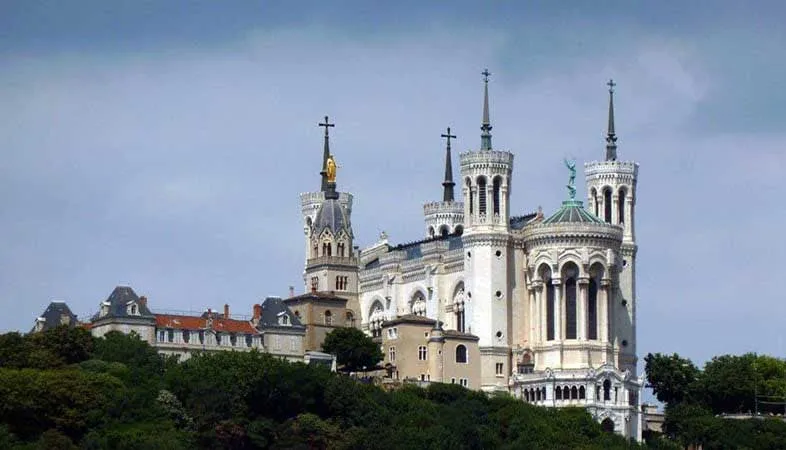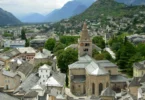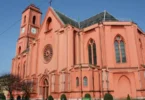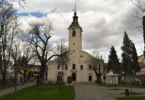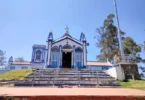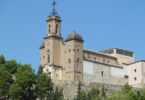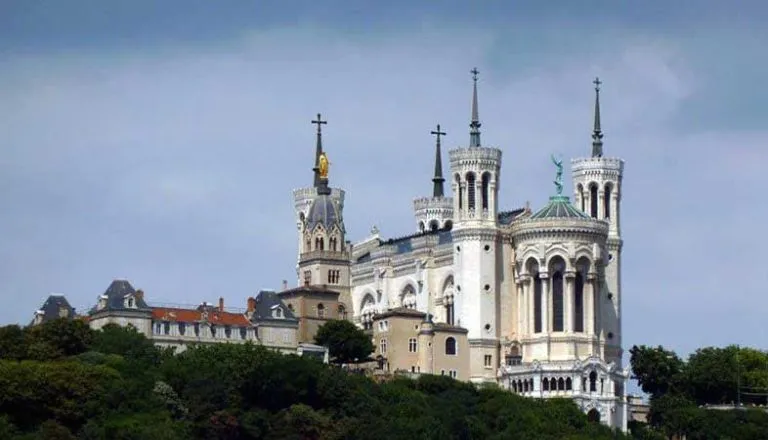
Introduction
The Basilica of Notre-Dame de Fourvière is a minor basilica in Lyon, France. It was built with private funds between 1872 and 1896 in a dominant position overlooking the city. The site it occupies was once the Roman forum of Trajan, the forum vetus (old forum), thus its name (as an inverted corruption of the French Vieux-Forum).
Fourvière has always been a popular place of pilgrimage. There has been a shrine at Fourvière dedicated to Our Lady since 1170. The chapel and parts of the building have been rebuilt at different times over the centuries, the most recent major works being in 1852 when the former steeple was replaced by a tower surmounted by a golden statue of the Virgin Mary sculpted by Joseph-Hugues Fabisch (1812–1886).
On 23 July 1816 twelve Marist aspirants, priests and seminarians, climbed the hill to the shrine of Our Lady of Fourvière and placed their promise to found the Society of Mary (Marists) under the corporal on the altar while Jean-Claude Courveille celebrated Mass.
On September 30, 1821 André Coindre and ten others made private vows in the chapel there, thus founding the Fratres a Sacratissimo Corde Iesu (Brothers of the Sacred Heart), a Roman Catholic religious community primarily devoted to educating youth.
On 21 January 1851, Peter Julian Eymard prayed at the Shrine of Our Lady of Fourvière and was inspired to found the Congregation of the Blessed Sacrament. When the city of Lyon was spared in the Franco-Prussian War (1870), the community committed to build the present Basilica alongside the ancient chapel.
The basilica Notre-Dame of Fourvière is the work of the architects Pierre Bossan and Sainte-Marie Perrin. It was built thanks to a public subscription in 1872 and consecrated in 1896. The basilica is at the top of “the hill which prays”. It is dedicated to the Virgin Mary and is listed as a historical monument, registered to the UNESCO World Heritage Site. Today, considered as the emblem of the city of Lyon.
History of Basilica of Notre-Dame de Fourvière, Lyon, France
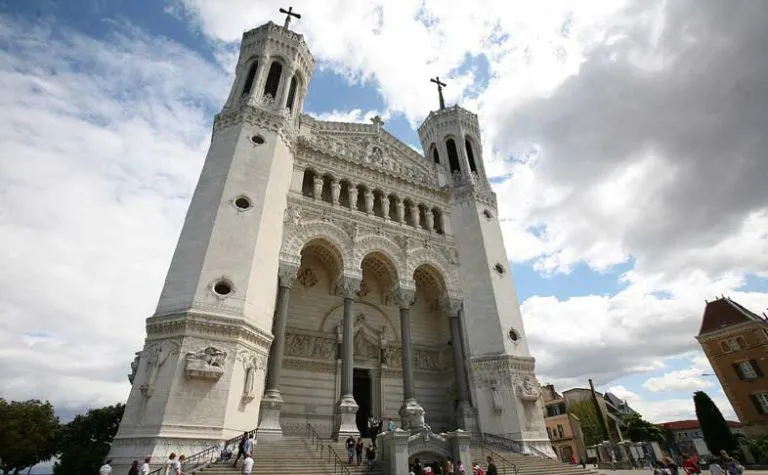
Fourvière is dedicated to the Virgin Mary, to whom is attributed the salvation of the city of Lyon from the bubonic plague that swept Europe in 1643. Each year in December 8th day of the Immaculate Conception, Lyon thanks the Virgin for saving the city by lighting candles throughout the city, in what is called the Fête des Lumières or the Festival of Lights. The Virgin is also credited with saving the city a number of other times, such as from a Cholera epidemic in 1832, and from Prussian invasion in 1870.
During the Franco-Prussian War, Prussian forces, having taken Paris, were progressing south towards Lyon. Their halt and retreat were, once again, attributed by the Church to the intercession of the Virgin Mary.
Speculating on the reasons for the construction of such an elaborate and expensive building, one author makes the statement that: “The reaction to the communes of Paris and Lyon were triumphalist monuments, the Sacré-Coeur of Montmartre and the basilica of Fourvière, dominating both cities. These buildings were erected with private funds, as gigantic ex-votos, to thank God for victory over the socialists and in expiation of the sins of modern France.”
Perched on top of the Fourvière hill, the basilica looms impressively over the city of Lyon, from where it can be seen from many vantage points; not unintentionally, the Basilica of Fourvière has become a symbol of the city. The Basilica, which offers guided tours and contains a Museum of Sacred Art, receives welcomes over 2.5 million pilgrims and visitors each year.
At certain times, members of the public may access the basilica’s north tower for a spectacular 180-degree view of Lyon and its suburbs. On a clear day, Mont Blanc, the highest point in Europe, can be seen in the distance.
Architecture of Basilica of Notre-Dame de Fourvière, Lyon, France
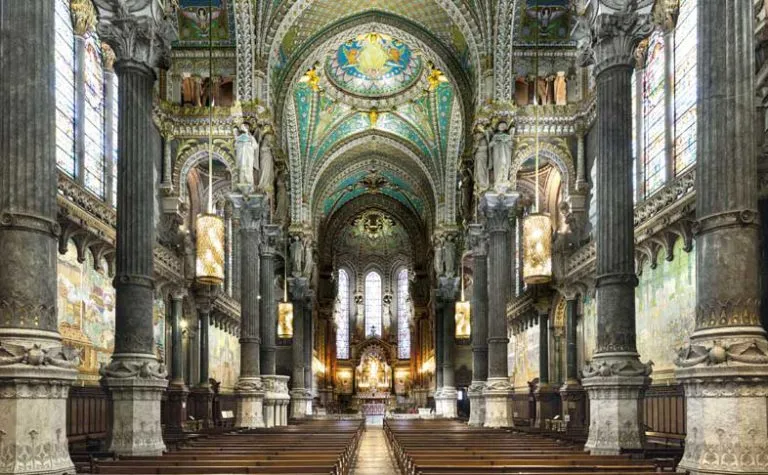
The basilica Notre-Dame of Fourvière is the work of the architects Pierre Bossan and Sainte-Marie Perrin. The design of the basilica, by Pierre Bossan, draws from both Romanesque and Byzantine architecture, two non-Gothic models that were unusual choices at the time. It has a bell tower topped with a gilded statue of the Virgin Mary. It features fine mosaics, superb stained glass, and a crypt of Saint Joseph.
The basilica Notre-Dame of Fourvière is 86 meters long and 35 meters wide. It offers a unique architecture with a byzantine, gothic and romanesque inspiration. It has got 4 towers, 48 meters high, which represent the cardinal virtues :
- Prudence (North-East tower) and Temperance (South-East tower) facing the city of Lyon.
- Force (North-West tower) and Justice (South-West tower) dominating the square.
Fourvière actually contains two churches, one on top of the other. The upper sanctuary is very ornate, while the lower is a much simpler design. Work on the triumphant basilica was begun in 1872 and finished in 1884. Finishing touches in the interior were not completed until as late as 1964.
Bossan’s first sketches for the basilica seem to date from 1846. At the time he was in Palermo. The basilica has acquired the local nickname of “the upside-down elephant”, because the building looks like the body of an elephant and the four towers look like its legs.
A Majestic Decor
The inside of Notre-Dame of Fourvière Basilica is composed of 2 churches one upon the other, with extraordinary volumes, accessible from the square. The higher Church is dominated by 3 domes and lit by 6 stained-glass windows offering a light emphasizing a rich decor. The materials used for the building and the decoration rival in quality and beauty, white marble from Carrara, pink granite from the North of Italy, blue marble from Savoy, green onyx, silver and gold pieces, union of ebony and ivory.
Composed of 3 big naves and 3 vaulted spans, gothic arches, the whole of the higher church is supported by 16 columns. There are 8 chapels and the apse is lit thanks to 7 high stained- glass windows. On the side walls 6 large mosaics of 50 square metres, by Charles Lameire et Georges Décote, show, on the left, the link of Mary to the Church and on the right the relationship of Mary with France.
The House of Mary
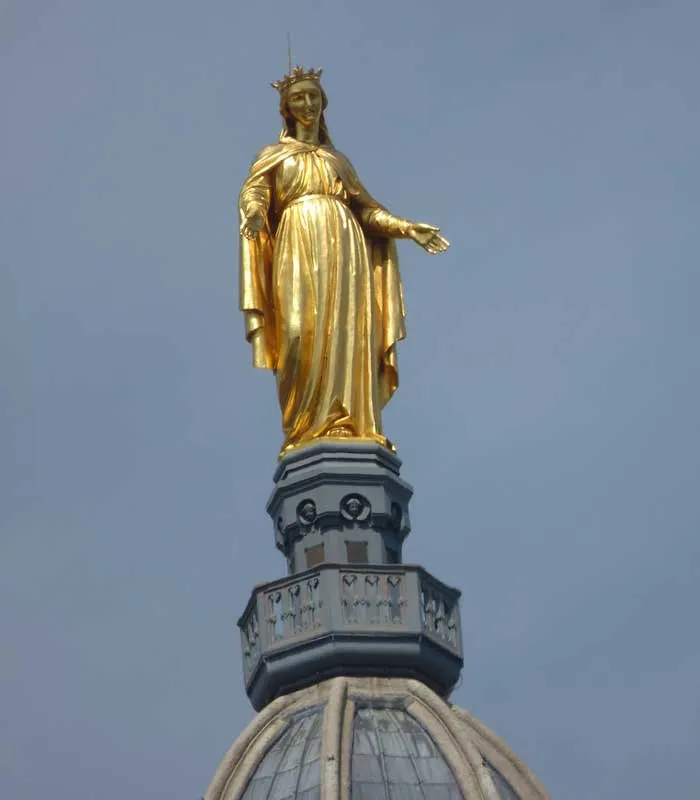
The sanctuary Notre-Dame de Fourviere is “the Marian soul of Lyon”. For centuries, it has attracted more than tens of thousands of pilgrims from all around the world. Countless Christians, both inside and outside of France, have recognized the sanctuary as a sacred place of veneration for the Virgin Mary. Rather quickly, in the early churches, Mary’s position became significant.
She is the mother of Jesus who said ‘yes’ to God and welcomed his power and the Holy Spirit. For the basilica, the art used by the architect Pierre Bossan is combined with the faith, to form a poem to the glory of Mary. His sources of mystical inspiration are the Apocalypse of St. John and the writings of a Spanish nun, Mary of Agreda.
The Coronation of the Virgin

The coronation of the Virgin by Millefaut takes place on the day of the closure of the international marian Congress organized in Lyon on the 8th of September 1900. The crown made by the goldsmith Armand-Caillat is not put directly on the Virgin’s head. It is held by two winged angels who seem to come down from heaven.
It is made of gold, it weighs more than 4 kg and is enriched with 1791 precious stones and pearls given by the Lyonese families as a sign of devotion to the Virgin Mary, protector of the city. Nowadays only the facsimile made when the Germans were arriving in 1940 can be seen. The genuine crown, stolen in May 2017, is still searched.
Beginning of the Festival of Lights
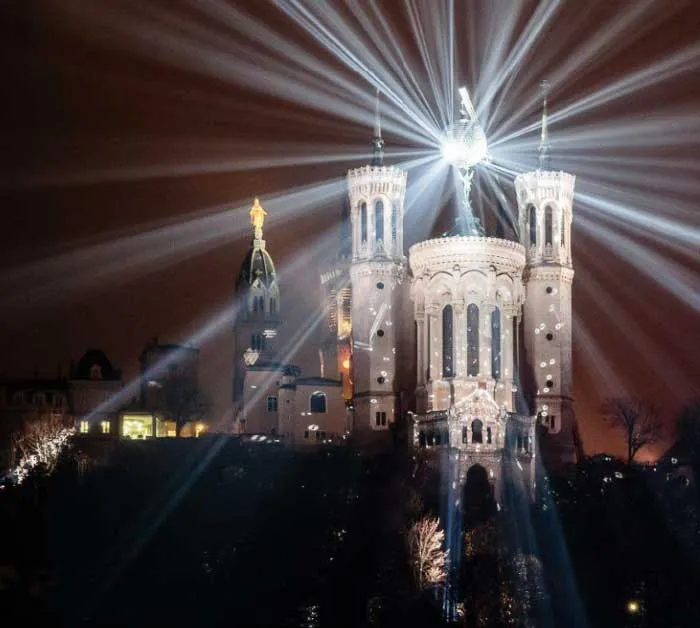
In the middle of the 19th century, the people of Lyon inaugurated the golden Statue of the Virgin Mary. These celebrations were the origin of a festival which now brings together more than two million people each year.
In 1848, the chapel’s old bell tower lost its turret, called “the needle”. The architect Duboys designed the bell tower’s reconstruction. However, his design wasn’t much appreciated. The decision was made to put a statue of the Virgin on top of the new bell tower. Joseph-Hugues Fabisch won the competition and made the Virgin statue in golden bronze. It is 5.60 meters high (18 ft).
This huge statue should have been erected on the 8th of September 1852 but a rise of the Saone River resulted in flooding of the foundry workshop, so the inauguration was postponed. Eventually the golden statue of the Virgin was inaugurated on the 8th of December.
Huge celebrations were planned, but the fireworks were cancelled due to bad weather. When the bad weather lifted, the inhabitants of Lyon spontaneously lit up the city by placing lights on their window-sills. Two years later, this improvised festival took on a life of its own when the doctrine of the Immaculate Conception was proclaimed.
Today, a large procession takes place every December 8th, from Saint Jean to Fourvière. At dusk, Catholics light up their windows with candles. For several years the city of Lyon has organised the “Festival of Lights” which brings together two million people in Lyon for four days of festivities.
The golden Virgin weighs more than 3 tons. The hands of the Virgin have been over proportioned so they can be seen from the bottom of the hill.
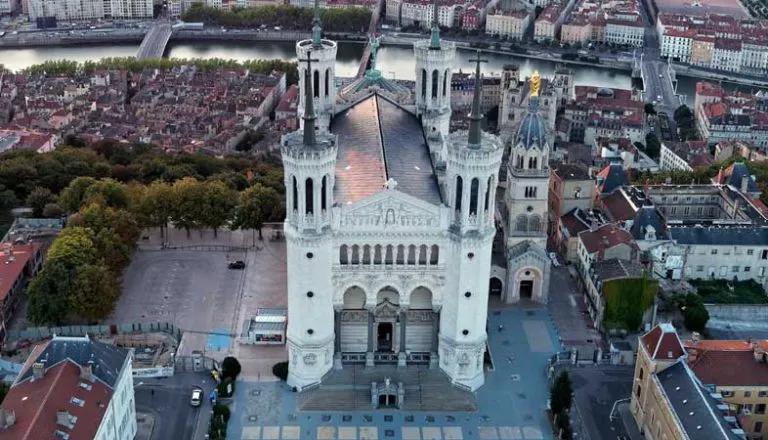
From the Middle Ages to the First Vows
In the 12th century, Lugdunum becomes Lyon and realizes that the cult to the Virgin Mary takes a big importance in the Christian devotion.
To a sanctuary dedicated to Mary – In 1168, Olivier de Chavannes, Dean of the cathedral chapter, oversaw building of the first chapel dedicated to the Virgin Mary, built on the hill of Fourvière. A second chapel was dedicated to Thomas Becket, archbishop of Canterbury, an English martyr who stayed in France during his exile.
In 1562, the chapels were destroyed because the city was captured by the Protestant armies of the Baron des Adrets. Apart from two capitals there is nothing left of the medieval sanctuary. The entire edifice was constructed again at the end of the 16th century. At this time Lyon had entered its second Golden Age, ushering economic prosperity. The chapels were of the utmost importance in Lyon’s religious life and soon extension works were necessary.
In 1623: Fourvière is so popular that more than 25 masses are celebrated every day.
The Origin of the Basilica: The 3 Vows of Fourvière
1638: Vow of the General Charity
When a serious scurvy epidemic affected the city’s children, nothing could stop the disease. The hospital administrators decided to walk in a procession to Fourvière. The disease decreased, disappeared, and never came back to Lyon again.
1643: The Aldermen’s Vow
In 1643 when Black Death, also known as the Great Plague, raged in Europe, Lyon was threatened by this curse. The notables decided to place the city under the protection of Mary. So, on the 8th September 1643, day of the nativity of the Virgin Mary, the Provost of the Merchants (equivalent of our mayor) and his four Aldermen (deputy mayors) followed by a crowd of inhabitants of Lyon walk in procession to the hill of Fourvière.
In the Chapel of the Virgin they made the vow to go up every 8th September to listen to the mass and to offer the archbishop seven pounds of wax and candles and a gold crown if their wishes were fulfilled. The city was spared so the tradition is carried on even today, displaying affection from the people of Lyon to the Virgin Mary who protects their city.
The Aldermen’s vow: a stained-glass window depicting The Aldermen’s vow, made by Lucien Bégule in 1882 is visible in the Chapel of the Virgin.
1832: The Cholera Epidemic
Cholera affected the areas around Lyon and threatened the city: the archbishop recommended public prayers. Once again Lyon was spared from a curse and the people of Lyon thanked the Virgin Mary by asking the painter Victor Orsel to make a huge painting. Today it can be seen in the back of the basilica. It is an allegory of the defeat of this epidemic. It was begun in 1833 by the Lyonese painter Victor Orsel and finished by his student after his death. It is 6.75 meters high and 5 meters wide.
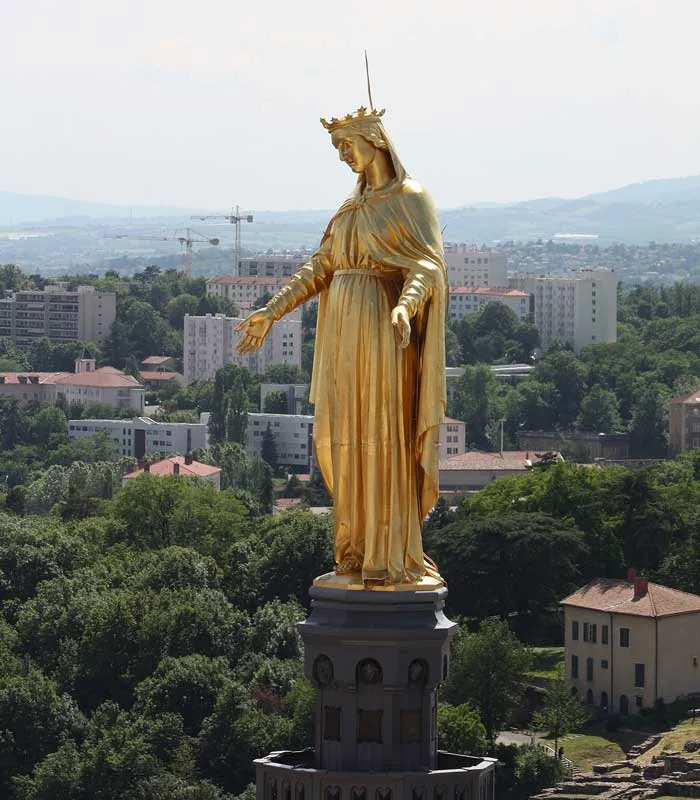
The 4th Vow of the people from Lyon
In 1870, the Prussians were invading France. So, a hundred ladies met the archbishop, his Eminence Ginoulhiac and made a vow, in Our Lady of Fourviere, praying to free the country and to protect Lyon. The archbishop promised the construction of a new sanctuary if the city was spared. The vow was fulfilled, the Prussians were arrested in Nuits-Saint-Georges and the Francfort treaty was signed on the 1st of March 1871. The first stone of the votive church Our Lady of Fourviere was laid in 1872.
Even today, a great procession which goes from Saint Jean to Fourvière takes place every December 8th and, at nightfall, Catholics illuminate their windows with candlesticks. For several years, the city of Lyon organized at this time the “Festival of Lights”, which brings together 2 million people in Lyon for four days.
Treasure
The treasure of Fourviere is one of the most emblematic in the city of Lyon. The largest part of the Treasure dates back to the end of the 19th century when the basilica was built. It is mostly composed of jewels of the 19th and 20th centuries, with master pieces by famous artists from Lyon or Paris, such as Armand-Calliat or Froment-Meurice.
Many families from Lyon, even low-income families, would contribute to the building of the basilica: often silver, but also items such as jewels, gems or golden embroidery. This act of gifting continues to this day, as a thanksgiving for a granted prayer, a recovery or an event that may be perceived as a miracle.
The Treasure of the cathedral is priceless. Some influential contributions enriched the Treasure. These included Cardinal Fesch, the nephew of Napoleon I, the Archbishop of Lyon and Napoleon III. These influential donors add to the priceless value of the Treasure. To honor these gifts, they are kept in service, used regularly for Liturgy in important ceremonies each year.
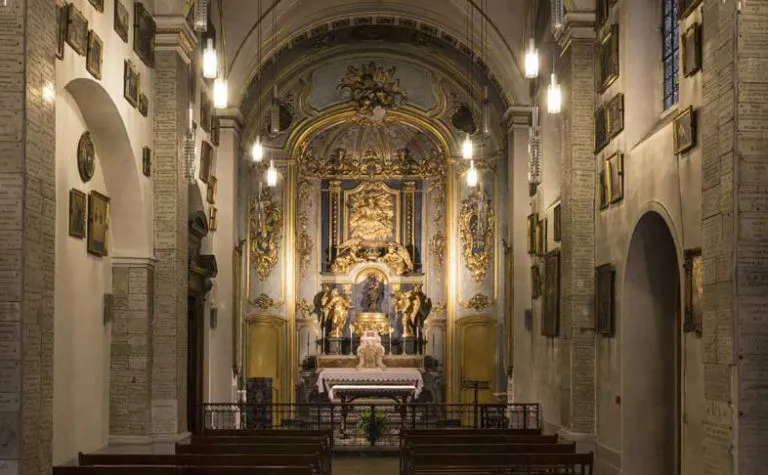
The Virgin’s Chapel
Built in the 12th century, it remains the historic and religious heart of the sanctuary. Founded in 1192, partly demolished in 1562 during the French wars of religion, then rebuilt, it was embellished in 1851. As early as the late 17th century, the walls were covered with ex-votos painted on canvas.
The Chapel of the Virgin was completely restored between 2007 and 2008. Chapel access is through the main entrance allowing light into the nave. The altar and the high altar are attributed to the baroque designer Jean Delamonce. Weekday Masses are held in the Chapel of the Virgin, as well as rosary, adoration and vespers.
Crypt
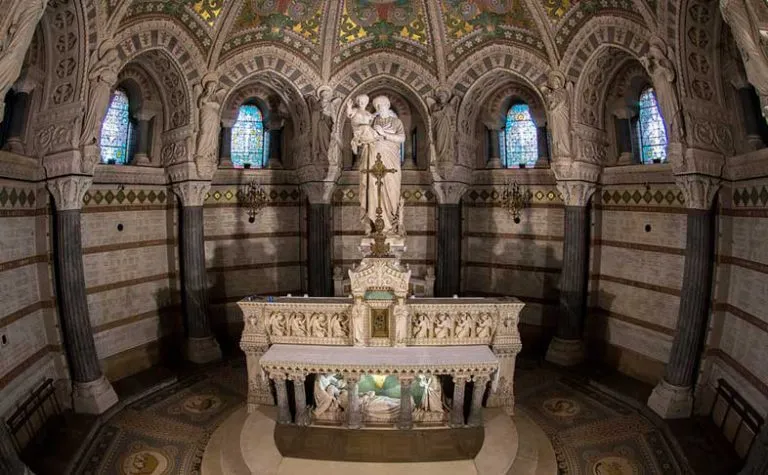
An impressive lower church welcoming Virgins from all over the world. This place is dedicated to St Joseph. For the architect, Pierre Bossan, the pilgrim had to “go to Mary through Joseph”, thus going from the darkness of the crypt to the light of the Basilica. The Door of the Lions on the East, located near the Gardens of the Rosary, was first planned to be the main access to the church.
It was never used as such because it was judged impractical. Carved in the marble walls of the crypt are the names of parishes who have offered donations. The ex-voto also become an integral part of the walls; they are engraved there, on demand for answered prayers. The crypt of Fourvière is characterised by a powerful and oppressive nature emphasised by the unfinished sculptures.
Basilica Choir
Les Petits Chanteurs de Saint-Marc, The Children’s Choir of Saint Mark, is the official choir of the Basilica of Notre-Dame de Fourvière.
This choir became well-known following the release of the 2004 film Les Choristes. The choir’s director is Nicolas Porte.
Feast Day - 11th April
Annual Feast Day of Our Lady of Fourviere held on 11th April.
Mass Time
Weekdays
Sundays
Church Visiting Time
Contact Info
8, Pl. de Fourvière,
69005, Lyon, France.
Phone No.
Tel : +33 4 78 25 13 01
Accommodations
How to reach the Basilica
Lyon–Saint Exupéry Airport, formerly known as Lyon Satolas Airport is the nearby Airport to the Basilica.
Vieux Lyon – Cathédrale Saint-Jean Transit Stop in Lyon, France is the nearby Train Station to the Basilica.

